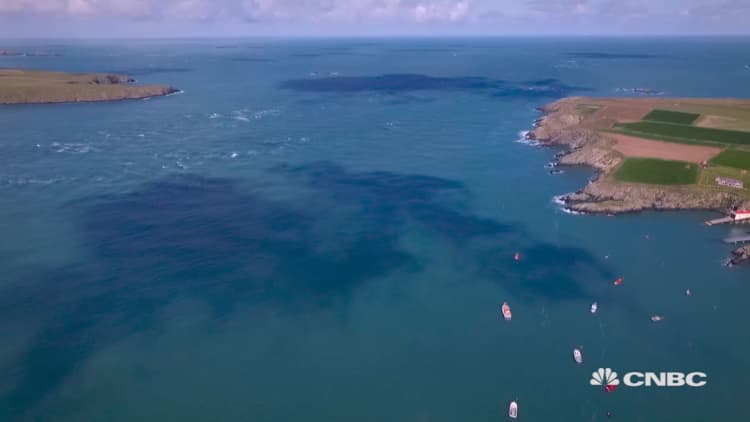
As the world's energy demand grows, governments and agencies are on the lookout for new sources. Could our oceans be the next big untapped resource?
On the Pembrokeshire coast in Wales, Tidal Energy Ltd. (TEL) are looking to harness the potential of the Atlantic Ocean with the Delta Stream, their "full-scale tidal stream generating device."
One of the company's units has been installed at Ramsey Sound in order to demonstrate the technology's potential. According to TEL, the location is "ideal" because, among other things, it is sheltered from prevailing wave and wind conditions, has fast tidal streams and a "suitable grid connection."
"The tidal flow there is quite strong and in a northerly direction when it's flooding and in a southerly direction when it's ebbing, what we do is to capture that kinetic energy, that movement of the body of water," Clive Adshead, operations manager for TEL, told CNBC's Sustainable Energy.
"We do that by putting an underwater 'windmill', if you like, on the seabed and allowing that movement of the water to rotate the generator, hence producing electricity," Adshead added.
Adshead went on to say that the single turbine sat on the seabed is able to produce 400 kilowatts of electricity. "Now, once you apply a power factor to that – which is reducing that output because of the tidal flow – that comes down to about 100 kilowatts."
Over a 24 hour period, this would produce 2,400 kilowatt hours, Adshead said, enough to power 200 houses for a day. There's potential for the turbine to be bigger, with a 700 kilowatt generator replacing the 400 kilowatt one.
With around two-thirds of the planet covered in water, the potential of technology looking to harness the power of the ocean is considerable.
"Ultimately, we're looking to develop the technology to send it all round the world to provide clean energy for the local people," Chris Williams, development director for TEL, said.
While the possibility of huge amounts of clean energy from tidal power is tantalizing, there are concerns about the impact such installations and units may have on wildlife.
TEL say that they are "highly sensitive" to the potential effects their projects may have on the environment and says that an Environmental Impact Assessment is undertaken by independent consultants on sites selected for development. This assessment covers everything from oceanography to ornithology and marine ecology.
Referring to the project at Ramsey Sound, the development director for TEL said that an important part of the project was to understand how its turbine interacts with the environment.
"This is a very sensitive area with regard to marine mammals, there's several thousand seals in the area and a pod of porpoise which frequent here on a regular basis," Chris Williams said.
Vantage point surveying – with observers standing on cliff tops – is used to analyse how many marine mammals are in the area, while sonar is used to gain an understanding of how marine mammals move around the turbine.
Could tidal power become one of the most dominant forms of clean energy? "At the moment, this is not commercially viable, however, our projections are showing it very much will be in the near future," Williams said.
"If you look at offshore wind for instance, over the last 20 years offshore wind has been developed around the world – primarily in Europe – and those costs now are getting down to a level where people consider are reasonable with regard to how much it should cost the consumer," he added.
Williams went on to say that tidal power could become competitive with offshore wind "within the next 10 years."




